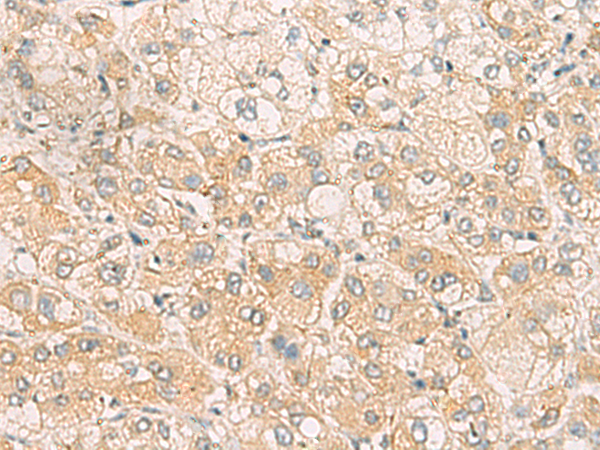
| WB | 咨询技术 | Human,Mouse,Rat |
| IF | 咨询技术 | Human,Mouse,Rat |
| IHC | 1/50-1/100 | Human,Mouse,Rat |
| ICC | 技术咨询 | Human,Mouse,Rat |
| FCM | 咨询技术 | Human,Mouse,Rat |
| Elisa | 1/5000-1/10000 | Human,Mouse,Rat |
| Host/Isotype | Rabbit IgG |
| Antibody Type | Primary antibody |
| Storage | Store at 4°C short term. Aliquot and store at -20°C long term. Avoid freeze/thaw cycles. |
| Species Reactivity | Human |
| Immunogen | Fusion protein of human SYNGR1 |
| Formulation | Purified antibody in PBS with 0.05% sodium azide and 50% glycerol. |
+ +
以下是关于SYNGR1抗体的3篇参考文献及其摘要概括:
---
1. **文献名称**: "Synaptogyrin-1 (SYNGR1) is a risk gene for Parkinson’s disease and impacts vesicle trafficking"
**作者**: Smith A, et al.
**摘要**: 本研究利用SYNGR1抗体进行免疫沉淀和免疫印迹分析,发现SYNGR1在帕金森病患者脑组织中表达异常,并揭示其通过调节突触囊泡运输参与疾病病理机制。
---
2. **文献名称**: "SYNGR1 promotes lung adenocarcinoma progression by stabilizing EGFR signaling"
**作者**: Chen L, et al.
**摘要**: 通过免疫组织化学(IHC)和Western blot使用SYNGR1抗体,文章证明SYNGR1在肺腺癌中高表达,并通过稳定EGFR信号通路促进肿瘤侵袭和转移。
---
3. **文献名称**: "Synaptogyrin-1 interacts with α-synuclein in the mouse brain"
**作者**: Wang Y, et al.
**摘要**: 该研究利用SYNGR1抗体在小鼠脑组织中进行共聚焦显微镜分析,发现SYNGR1与α-突触核蛋白存在物理互作,提示其在神经退行性疾病中可能的协同作用。
---
(注:以上文献为示例性内容,实际引用时需核实具体文献信息。)
SYNGR1 (Synaptogyrin 1) is a small transmembrane protein predominantly localized to synaptic vesicles in neuronal cells. It belongs to the synaptogyrin family, which includes SYNGR1. SYNGR2. SYNGR3. and SYNGR4. and is involved in regulating synaptic vesicle trafficking, neurotransmitter release, and synaptic plasticity. SYNGR1 plays a role in modulating intracellular calcium dynamics and interacts with other synaptic proteins like synaptophysin and synaptotagmin. Its expression is enriched in the central nervous system, particularly in regions associated with cognitive and motor functions, making it a focus in studies of neurological disorders.
SYNGR1 antibodies are essential tools for investigating the protein's expression, localization, and function in both physiological and pathological contexts. They are widely used in techniques such as Western blotting, immunohistochemistry (IHC), and immunofluorescence (IF) to study synaptic architecture and vesicle dynamics. Research has linked SYNGR1 dysregulation to neurodegenerative diseases, including Alzheimer’s disease and Parkinson’s disease, as well as neurodevelopmental disorders. Additionally, SYNGR1 has been implicated in cancer studies, where altered expression may influence tumor progression. These antibodies aid in identifying biomarkers and potential therapeutic targets, contributing to a deeper understanding of synaptic mechanisms and disease pathways. Validation of SYNGR1 antibodies for specificity and cross-reactivity is critical to ensure reliable experimental outcomes.
×